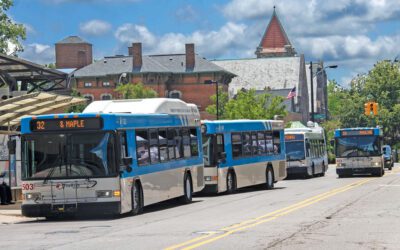Within just a few short blocks of downtown Dexter, eleven acres of land that were once used for industrial operations are being transformed into housing developments. At 150 Jeffords, where dilapidated trailers and commercial buildings once stood, there will be a four-story building with commercial space at ground level and twenty-two residential units above. Just a block away, at 3045 Broad St., there’s a plan to build up to ninety new condominiums on the site of the old DAPCO factory. Just past Forest Lawn Cemetery, two duplexes under construction are the first of seventy-six units in a development called Grandview Commons. From there, it’s a quick walk to Main St.
“There will be a lot of activity in a small area,” says Michelle Aniol, Dexter’s community development manager. With no residential units currently available downtown, the developments will help to satisfy growing demand.
Dexter, Chelsea, and Saline are beginning to mirror larger cities, with new housing intertwined with old commercial districts. As more people crave to live in downtowns, developers are turning to former industrial properties to meet the need. Once, workers walked to their jobs here. Now, new upscale abodes offer an easy walk to downtown restaurants, shops, and cultural amenities.
At the old DAPCO site, Norfolk Homes has a concept plan that includes eighty to ninety condos, plus retail and office space. The city, which owns the land, entered into a predevelopment agreement with Foremost Development Company in 2015, but the developer and the city agreed to let it lapse. Aniol says Foremost had a preconceived vision–luxury apartments–that wasn’t what the city wanted. Norfolk, she says, is working with the city to develop a project that responds to the community’s needs. It’s holding a series of community engagement workshops to get input on a suitable density and scale. The goal is to start construction in roughly a year. “Norfolk has been fantastic. They learned a lot about the community, and the community learned about what’s possible,” says Zach Michels, a city council member who served on the site committee. He says the new developments will serve people who are eager to move from the newer subdivisions on the outskirts and will help keep downtown vital. With more than 150 units between the Grandview and DAPCO sites, he says, “that’s a lot of money that comes in to support local businesses.”
The units at Grandview Commons–duplexes, townhomes, and condos–are being built by A.R. Brouwer on the site of the former Sweepster/Pilot factory. It’s a $22-$25 million project. So far, two of the four duplex units have been sold, and tenants are expected to move in by December. Steve Brouwer, the company’s founder and president, says a one-bedroom, 1,050-square-foot unit is $284,000, while a 2,650-square-foot three-story townhome will cost $599,000. All the units have granite countertops and stainless-steel appliances and several will have views of Mill Creek.
To fit in with Dexter’s historic architecture, there will be gabled roofs on all Grandview Commons units and an extensive use of brick. But though Brouwer’s project met all the city requirements, Michels feels the development is too suburban “and looks like it belongs more in Pittsfield Township instead of two blocks from downtown.”
There’s also concern about the price. Michels, director of planning and zoning for Dexter Township, would have preferred a denser development, with more and less expensive units. Brouwer acknowledges that higher density could bring down the housing costs, but says his company must meet zoning, engineering, and landscaping requirements, and more residents would require more parking. A park area, which the city council wanted, also took away room for housing.
Downtown living isn’t new–some downtown buildings have upstairs apartments that date back a century or more. Those are more affordable, but they aren’t abundant. Aniol says city council plans to set up a committee to explore housing affordability. The key, she says, is to determine whether a firefighter, teacher, or owner of a local coffee shop can afford to live downtown. The city doesn’t want only the wealthy living downtown: “We want a nice, healthy, diverse mix of people. That makes for a more vibrant city.”
—
In Chelsea, developer Joe Ziolkowski is redeveloping the Mack Building, on the corner of Main and Jackson. It was built in 1901 by the Chelsea Manufacturing Company and most recently was Longworth Plating. As manufacturers moved to more flexible and accessible buildings in industrial parks, it sat vacant for six years before the city bought in 2008.
Ziolkowski previously bought and rehabbed the former police station on Middle St. Disturbed by the languishing Mack Building, he thought, “I can either keep looking at it or try to do it myself,” adding that its high visibility on Main St. was “really a black eye on the city.” He purchased the 7,700-square-foot building in August 2015. The redevelopment is a $1.7 million-plus project; the city is paying $260,000, while the Michigan Economic Development Corporation is providing $680,000 in grant money for blight elimination. There will be four apartments upstairs, while the first floor will have three or four food-oriented businesses. The project is due to be completed by March 2019.
A condition of the Mack Building grants is a historic preservation review, ensuring that the work is faithful to the building’s original character. While the interior has been gutted and reframed to ensure it is structurally sound and up to code, the building’s shell remained intact, keeping the original facade.
Ziolkowski says he could have built a new structure for half the cost of preserving and updating the old one. But there was grant money available to help with that–and a new building “would never quite have the [same] feel or history.”
Chelsea city councilmember Tony Iannelli says developers always need to weigh whether it’s more cost effective to remodel or build something new. But, he says, Chelsea has a “unique, small-town charm to it, and any of the residents you would talk to would want to preserve that as much as possible.” And with a shortage of residential options downtown, he sees the appeal to refurbishing old buildings for residential use.
Jan Bernath, who is on the board of the Chelsea Area Historical Society, says these types of renovations help connect the town to its past and provide diversity in architecture. Society member Kathy Clark, who has written extensively about Chelsea’s history, is disappointed that the building was allowed to deteriorate so badly. “It’s totally gutted, and all the [interior] remnants are gone.” Bernath acknowledges that it’s “a shell of its former self, but architecturally, it’s still a contribution to the visual landscape.”
Another industrial-to-residential conversion may be on the horizon. Iannelli says Norfolk Homes has bought the Rockwell Building on Railroad St., built in 1906 and originally part of the Glazier Stove campus. The company is contemplating converting it to condos, with construction to possibly begin next year. (Norfolk did not respond to requests for comment.)
—
In Saline, the residential vacancy rate downtown is less than 10 percent, says Holli Andrews, executive director of Saline Main Street, a nonprofit focused on the revitalization of downtown Saline. The more people living downtown, the better it is for small businesses, she says. As in Dexter and Chelsea, developers are looking at former factory sites to accomodate them.
An industrial site on Maple between Michigan Ave. and Woodland recently housed the Department of Public Works, a police station, and a senior center. Now it is being turned into a model inclusive development. Vacant since 2007, it was sold to Three Oaks Communities in October 2017, and the company began construction that month.
Three Oaks founder Bill Godfrey says they are the first private developer to build a neighborhood of homes for the general public that also includes customized homes for adults with intellectual and developmental disabilities. The neighborhood, called Maple Oaks, will include ten single-family homes, sixteen townhomes, and eight condos set up in a multifamily format with large community rooms for special-needs adults. Construction costs will exceed $7 million.
Godfrey says the idea emerged after he met with families in Saline who needed housing and services for their special-needs adult children. It’s personal for him: His uncle was intellectually disabled, and his mother, aunt, and sister managed his care after Godfrey’s grandparents could no longer do so. Maple Oaks will have a community room staffed by a caregiver, security systems, heated bathroom floors, lower countertops, and ADA-standard handicapped accessibility. Godfrey says the entire development is already reserved, and 62 percent of the buyers have no connection to special needs. “The Saline community has embraced this,” he says. Single-family homes start at $250,000 for a three-bedroom, two-bath, 1,600-square-foot ranch. Condos start at $175,000; the first is slated to be finished within the next four months, with completion of the entire neighborhood expected by the end of 2019.
Saline Mayor Brian Marl says the response to Godfrey’s development “has been overwhelming. It’s a marvelous addition to the community,” providing housing for a demographic that’s often overlooked. He expects it will be a model emulated elsewhere. The fact that it sold out immediately also speaks to the desire to live in downtown Saline, he adds.
There’s also possible future housing at 147 Michigan Ave. Guenther Homes purchased the land in July 2017. Brian Brickley, sales manager for Guenther, says the company hasn’t yet decided what to build, but one option is a mix of condos and retail.
—
Redeveloping old factory sites often requires some kind of environmental cleanup–and sometimes, a lot. Five years ago, plans to build luxury condos on the site of the former Universal Die Casting factory were derailed by contamination left from a chrome-plating operation. Dexter’s Aniol says most such “brownfield” cleanups tend to be very straightforward. “It’s like following directions on making a cake. You follow the directions and end up with a really good cake,” she says. An extensive amount of cleanup was required in preparation for Grandview Commons, says Brouwer, including trucking a great deal of soil contaminated primarily with petrochemicals to a landfill in Salem Township.
In Chelsea, Ziolkowski says the environmental report on the Mack Building site “wasn’t as scary” as he expected. The remediation involves capping soil contaminated with heavy metals with a layer of concrete. This exceeds state environmental requirements by adding an additional concrete slab on top of an existing one, he says.
Iannelli says the former Federal Screw Works property in Chelsea, built in 1916, would make for an ideal residential development. All but two of the buildings were demolished, and they have been vacant since 2005. But he says it cannot be used for housing due to extensive contamination.
Bernath disagrees and has been active, along with Clark, in trying to preserve the buildings. The company’s “office on Congdon St. is the last Art Nouveau building we have in town,” she says. She adds that while there is now a deed restriction in place that excludes residential development, the DEQ has told her that a developer could work with it on a plan to use tax credits and grants for mitigation and cleanup. She says using only the second floor for residences would make the cleanup less arduous.
Despite the challenges involved in cleanup and preservation, many, like Bernath, view redeveloping industrial sites as a worthwhile way to keep their cities vital and relevant. She sees the trend of residents migrating downtown as reminiscent of her youth. Now seventy-eight, she lived above a grocery store in Chelsea in 1947. “It’s the new urbanism,” she says.




